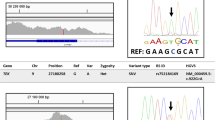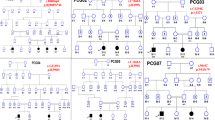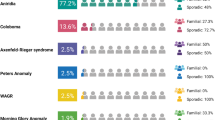Abstract
Developmental eye diseases, including cataract/microcornea, Peters anomaly and coloboma/microphthalmia/anophthalmia, are caused by mutations encoding many different signalling and structural proteins in the developing eye. All modes of Mendelian inheritance occur and many are sporadic cases, so provision of accurate recurrence risk information for families and affected individuals is highly challenging. Extreme genetic heterogeneity renders testing for all known disease genes clinically unavailable with traditional methods. We used whole-exome sequencing in 11 unrelated developmental eye disease patients, as it provides a strategy for assessment of multiple disease genes simultaneously. We identified five causative variants in four patients in four different disease genes, GJA8, CRYGC, PAX6 and CYP1B1. This detection rate (36%) is high for a group of patients where clinical testing is frequently not undertaken due to lack of availability and cost. The results affected clinical management in all cases. These variants were detected in the cataract/microcornea and Peters anomaly patients. In two patients with coloboma/microphthalmia, variants in ABCB6 and GDF3 were identified with incomplete penetrance, highlighting the complex inheritance pattern associated with this phenotype. In the coloboma/microphthalmia patients, four other variants were identified in CYP1B1, and CYP1B1 emerged as a candidate gene to be considered as a modifier in coloboma/microphthalmia.
Similar content being viewed by others
Log in or create a free account to read this content
Gain free access to this article, as well as selected content from this journal and more on nature.com
or
References
Jamieson RV, Perveen R, Kerr B et al: Domain disruption and mutation of the bZIP transcription factor, MAF, associated with cataract, ocular anterior segment dysgenesis and coloboma. Hum Mol Genet 2002; 11: 33–42.
Semina EV, Ferrell RE, Mintz-Hittner HA et al: A novel homeobox gene PITX3 is mutated in families with autosomal-dominant cataracts and ASMD. Nat Genet 1998; 19: 167–170.
Nolen LD, Amor D, Haywood A et al: Deletion at 14q22-23 indicates a contiguous gene syndrome comprising anophthalmia, pituitary hypoplasia, and ear anomalies. Am J Med Genet A 2006; 140: 1711–1718.
Hansen L, Yao W, Eiberg H et al: Genetic heterogeneity in microcornea-cataract: five novel mutations in CRYAA, CRYGD, and GJA8. Invest Ophthalmol Vis Sci 2007; 48: 3937–3944.
Hanson IM, Fletcher JM, Jordan T et al: Mutations at the PAX6 locus are found in heterogeneous anterior segment malformations including Peters’ anomaly. Nat Genet 1994; 6: 168–173.
Vincent A, Billingsley G, Priston M et al: Phenotypic heterogeneity of CYP1B1: mutations in a patient with Peters' anomaly. J Med Genet 2001; 38: 324–326.
Summers KM, Withers SJ, Gole GA, Piras S, Taylor PJ : Anterior segment mesenchymal dysgenesis in a large Australian family is associated with the recurrent 17 bp duplication in PITX3. Mol Vis 2008; 14: 2010–2015.
Reis LM, Tyler RC, Schneider A et al: FOXE3 plays a significant role in autosomal recessive microphthalmia. Am J Med Genet A 2010; 152A: 582–590.
Doucette L, Green J, Fernandez B, Johnson GJ, Parfrey P, Young TL : A novel, non-stop mutation in FOXE3 causes an autosomal dominant form of variable anterior segment dysgenesis including Peters anomaly. Eur J Hum Genet 2011; 19: 293–299.
Bremond-Gignac D, Bitoun P, Reis LM, Copin H, Murray JC, Semina EV : Identification of dominant FOXE3 and PAX6 mutations in patients with congenital cataract and aniridia. Mol Vis 2010; 16: 1705–1711.
Gregory-Evans CY, Williams MJ, Halford S, Gregory-Evans K : Ocular coloboma: a reassessment in the age of molecular neuroscience. J Med Genet 2004; 41: 881–891.
Verma AS, FitzPatrick DR : Anophthalmia and microphthalmia. Orphanet J Rare Dis 2007; 2: 47.
Bakrania P, Efthymiou M, Klein JC et al: Mutations in BMP4 cause eye, brain, and digit developmental anomalies: overlap between the BMP4 and hedgehog signaling pathways. Am J Hum Genet 2008; 82: 304–319.
Mihelec M, Abraham P, Gibson K et al: Novel SOX2 partner-factor domain mutation in a four-generation family. Eur J Hum Genet 2009; 17: 1417–1422.
Li H, Durbin R : Fast and accurate short read alignment with Burrows–Wheeler transform. Bioinformatics 2009; 25: 1754–1760.
Li H, Handsaker B, Wysoker A et al: The Sequence Alignment/Map format and SAMtools. Bioinformatics 2009; 25: 2078–2079.
McKenna A, Hanna M, Banks E et al: The Genome Analysis Toolkit: a MapReduce framework for analyzing next-generation DNA sequencing data. Genome Res 2010; 20: 1297–1303.
Wang K, Li M, Hakonarson H : ANNOVAR: functional annotation of genetic variants from high-throughput sequencing data. Nucleic Acids Res 2010; 38: e164.
Ng PC, Henikoff S : Predicting deleterious amino acid substitutions. Genome Res 2001; 11: 863–874.
Adzhubei IA, Schmidt S, Peshkin L et al: A method and server for predicting damaging missense mutations. Nat Methods 2010; 7: 248–249.
Schwarz JM, Rodelsperger C, Schuelke M, Seelow D : MutationTaster evaluates disease-causing potential of sequence alterations. Nat Methods 2010; 7: 575–576.
Liu X, Jian X, Boerwinkle E : dbNSFP: a lightweight database of human nonsynonymous SNPs and their functional predictions. Hum Mutat 2011; 32: 894–899.
de Ligt J, Willemsen MH, van Bon BW et al: Diagnostic exome sequencing in persons with severe intellectual disability. N Engl J Med 2012; 367: 1921–1929.
Neveling K, Collin RW, Gilissen C et al: Next-generation genetic testing for retinitis pigmentosa. Hum Mutat 2012; 33: 963–972.
Bermejo E, Martinez-Frias ML : Congenital eye malformations: clinical-epidemiological analysis of 1,124,654 consecutive births in Spain. Am J Med Genet 1998; 75: 497–504.
Devi RR, Vijayalakshmi P : Novel mutations in GJA8 associated with autosomal dominant congenital cataract and microcornea. Mol Vis 2006; 12: 190–195.
Stoilov I, Akarsu AN, Alozie I et al: Sequence analysis and homology modeling suggest that primary congenital glaucoma on 2p21 results from mutations disrupting either the hinge region or the conserved core structures of cytochrome P4501B1. Am J Hum Genet 1998; 62: 573–584.
Yu LC, Twu YC, Chou ML et al: The molecular genetics of the human I locus and molecular background explain the partial association of the adult i phenotype with congenital cataracts. Blood 2003; 101: 2081–2088.
Andley UP : Effects of alpha-crystallin on lens cell function and cataract pathology. Curr Mol Med 2009; 9: 887–892.
Ye M, Berry-Wynne KM, Asai-Coakwell M et al: Mutation of the bone morphogenetic protein GDF3 causes ocular and skeletal anomalies. Hum Mol Genet 2010; 19: 287–298.
Wang L, He F, Bu J et al: ABCB6 mutations cause ocular coloboma. Am J Hum Genet 2012; 90: 40–48.
Helias V, Saison C, Ballif BA et al: ABCB6 is dispensable for erythropoiesis and specifies the new blood group system Langereis. Nat Genet 2012; 44: 170–173.
Chavarria-Soley G, Sticht H, Aklillu E et al: Mutations in CYP1B1 cause primary congenital glaucoma by reduction of either activity or abundance of the enzyme. Hum Mutat 2008; 29: 1147–1153.
Pasutto F, Chavarria-Soley G, Mardin CY et al: Heterozygous loss-of-function variants in CYP1B1 predispose to primary open-angle glaucoma. Invest Ophthalmol Vis Sci 2010; 51: 249–254.
Chambers D, Wilson L, Maden M, Lumsden A : RALDH-independent generation of retinoic acid during vertebrate embryogenesis by CYP1B1. Development 2007; 134: 1369–1383.
Lupo G, Gestri G, O'Brien M et al: Retinoic acid receptor signaling regulates choroid fissure closure through independent mechanisms in the ventral optic cup and periocular mesenchyme. Proc Natl Acad Sci 2011; 108: 8698–8703.
Kloeckener-Gruissem B, Vandekerckhove K, Nurnberg G et al: Mutation of solute carrier SLC16A12 associates with a syndrome combining juvenile cataract with microcornea and renal glucosuria. Am J Hum Genet 2008; 82: 772–779.
Ponnam SP, Ramesha K, Tejwani S, Ramamurthy B, Kannabiran C : Mutation of the gap junction protein alpha 8 (GJA8) gene causes autosomal recessive cataract. J Med Genet 2007; 44: e85.
Burdon KP, Wirth MG, Mackey DA et al: Investigation of crystallin genes in familial cataract, and report of two disease associated mutations. Br J Ophthalmol 2004; 88: 79–83.
Bahn CF, Falls HF, Varley GA, Meyer RF, Edelhauser HF, Bourne WM : Classification of corneal endothelial disorders based on neural crest origin. Ophthalmology 1984; 91: 558–563.
Vincent A, Billingsley G, Priston M et al: Further support of the role of CYP1B1 in patients with Peters anomaly. Mol Vis 2006; 12: 506–510.
Fantes J, Ragge NK, Lynch SA et al: Mutations in SOX2 cause anophthalmia. Nat Genet 2003; 33: 461–463.
Ragge NK, Brown AG, Poloschek CM et al: Heterozygous mutations of OTX2 cause severe ocular malformations. Am J Hum Genet 2005; 76: 1008–1022.
Jimenez NL, Flannick J, Yahyavi M et al: Targeted ‘next-generation’ sequencing in anophthalmia and microphthalmia patients confirms SOX2, OTX2 and FOXE3 mutations. BMC Med Genet 2011; 12: 172.
Acknowledgements
We thank the families for their participation in this research. Support is acknowledged from the NHMRC and the Ophthalmic Research Institute of Australia.
Author information
Authors and Affiliations
Corresponding author
Ethics declarations
Competing interests
The authors declare no conflict of interest.
Additional information
Supplementary Information accompanies this paper on European Journal of Human Genetics website
Rights and permissions
About this article
Cite this article
Prokudin, I., Simons, C., Grigg, J. et al. Exome sequencing in developmental eye disease leads to identification of causal variants in GJA8, CRYGC, PAX6 and CYP1B1. Eur J Hum Genet 22, 907–915 (2014). https://doi.org/10.1038/ejhg.2013.268
Received:
Revised:
Accepted:
Published:
Issue date:
DOI: https://doi.org/10.1038/ejhg.2013.268
Keywords
This article is cited by
-
Demographics and histopathological characteristics of enucleated microphthalmic globes
Scientific Reports (2022)
-
BMP3 is a novel locus involved in the causality of ocular coloboma
Human Genetics (2022)
-
The genetic landscape of crystallins in congenital cataract
Orphanet Journal of Rare Diseases (2020)
-
The genetic architecture of aniridia and Gillespie syndrome
Human Genetics (2019)
-
Genetics of anophthalmia and microphthalmia. Part 1: Non-syndromic anophthalmia/microphthalmia
Human Genetics (2019)



